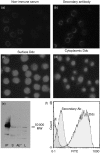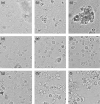Innate immunity in insects: surface-associated dopa decarboxylase-dependent pathways regulate phagocytosis, nodulation and melanization in medfly haemocytes
- PMID: 17983437
- PMCID: PMC2433321
- DOI: 10.1111/j.1365-2567.2007.02722.x
Innate immunity in insects: surface-associated dopa decarboxylase-dependent pathways regulate phagocytosis, nodulation and melanization in medfly haemocytes
Abstract
Phagocytosis, melanization and nodulation in insects depend on phenoloxidase (PO) activity. In this report, we demonstrated that these three processes appear to be also dependent on dopa decarboxylase (Ddc) activity. Using flow cytometry, RNA interference, immunoprecipitation and immunofluorescence, we demonstrated the constitutive expression of Ddc and its strong association with the haemocyte surface, in the medfly Ceratitis capitata. In addition, we showed that Escherichia coli phagocytosis is markedly blocked by small interfering RNA (siRNA) for Ddc, antibodies against Ddc, as well as by inhibitors of Ddc activity, namely carbidopa and benzerazide, convincingly revealing the involvement of Ddc activity in phagocytosis. By contrast, latex beads and lipopolysaccharide (LPS) did not require Ddc activity for their uptake. It was also shown that nodulation and melanization processes depend on Ddc activation, because antibodies against Ddc and inhibitors of Ddc activity prevent haemocyte aggregation and melanization in the presence of excess E. coli. Therefore, phagocytosis, melanization and nodulation depend on haemocyte-surface-associated PO and Ddc. These three unrelated mechanisms are based on tyrosine metabolism and share a number of substrates and enzymes; however, they appear to be distinct. Phagocytosis and nodulation depend on dopamine-derived metabolite(s), not including the eumelanin pathway, whereas melanization depends exclusively on the eumelanin pathway. It must also be underlined that melanization is not a prerequisite for phagocytosis or nodulation. To our knowledge, the involvement of Ddc, as well as dopa and its metabolites, are novel aspects in the phagocytosis of medfly haemocytes.
Figures









References
-
- Ashida M, Brey PT. Recent advances on the research of the insect prophenoloxidase cascade. In: Brey PT, Hultmark D, editors. Molecular Mechanisms of Immune Responses in Insects. London: Chapman & Hall; 1998. pp. 135–72.
-
- Cerenius L, Soderhall K. The prophenoloxidase-activating system in invertebrates. Immunol Rev. 2004;198:116–26. - PubMed
-
- Kanost MR, Jiang H, Yu XQ. Innate immune responses of a lepidopteran insect, Manduca sexta. Immunol Rev. 2004;198:97–105. - PubMed
-
- Mavrouli MD, Tsakas S, Theodorou GL, Lampropoulou M, Marmaras VJ. MAP kinases mediate phogocytosis and melanization via prophenoloxidase activation in medfly haemocytes. Biochim Biophys Acta. 2005;1744:145–56. - PubMed
-
- Lavine MD, Strand MR. Insect haemocytes and their role in immunity. Insect Biochem Mol Biol. 2002;32:1295–309. - PubMed
Publication types
MeSH terms
Substances
LinkOut - more resources
Full Text Sources

